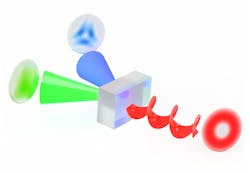A team of Wits University researchers led by Professor Andrew Forbes, head of the Structured Light Laboratory, recently found a way to send patterned light through obstructions without distorting the message, and it shows potential for applications ranging from quantum communications to microscopy—essentially anything that requires aberration correction (see video).
Structured light is currently used to send information through fiber-optic cables, and inserting patterns into these beams can significantly increase the amount of data that can be sent. The patterns resemble shapes like flower petals, or even donuts, and represent letters of the alphabet—and the message can be decoded after it’s received.
“We’re pushing toward large encoding alphabets for light, and to date we haven’t seen patterns of light used for commercial systems because they’re easily distorted,” says Forbes. “So we’re working hard to overcome this challenge. If we can, then 100 patterns will mean 100 extra channels for communicating.”
Environmental interference from air turbulence, aberrated optics, stressed fibers, or biological tissues can interfere with and distort the patterns, which can render the information encoded in patterns useless.
Nonlinear optics
To outmaneuver the interference issue, Forbes’ idea is to do adaptive optics, but eliminate the measurement step.
“To fix a distortion, we first need to measure what it is and then work out the correction,” says Forbes. “But it’s too time-consuming. Can we do ‘adaptive optics at the speed of light’ and without having to measure what the problem is? The answer we show is: Yes. The trick is to use nonlinear optics rather than linear optics.”
Forbes’ team’s method preserves the integrity of patterned light by pairing a structured light beam that contains coded information with an unstructured light beam before sending it through an environment in which it will likely encounter interference.
They pulled it off via difference frequency generation, where two beams of light are sent into a nonlinear crystal to create another beam that shares the properties of the two inputs.
“The key ingredient is a nonlinear crystal,” explains Forbes. “It takes two beams in and produces one as its output. Crucially, the output is the product of the two inputs, but one with the conjugate of the phase. In simple terms: the distortion on one beam cancels that of the other so the output is free of distortion.”
This method works even for the most complex forms of aberrations that rendered initial patterns unrecognizable, and its applications include essentially anything that requires aberration correction—ranging from communications to imaging to optical trapping.
It’s important to note the aberration correction is automatic and patterned light is corrected in real time.
Most surprising aspect of this work? “Realizing old nonlinear optics textbooks always held the answer, but we just didn’t see it,” says Forbes. “This is because the theory is typically developed for plane waves, so when you take the conjugate of nothing, you get nothing—and it’s not interesting. But when light has structure, it all changes and suddenly the old rules take on new meaning.”
Forbes and his team are busy “merging nonlinear optics with quantum information processing—which is highly challenging,” says Forbes. “But imagine error-free quantum processes!”
FURTHER READING
S. Singh et al., Adv. Photon., 6, 2, 026003 (Feb. 2024); https://doi.org/10.1117/1.ap.6.2.026003.

Sally Cole Johnson | Editor in Chief
Sally Cole Johnson, Laser Focus World’s editor in chief, is a science and technology journalist who specializes in physics and semiconductors. She wrote for the American Institute of Physics for more than 15 years, complexity for the Santa Fe Institute, and theoretical physics and neuroscience for the Kavli Foundation.
